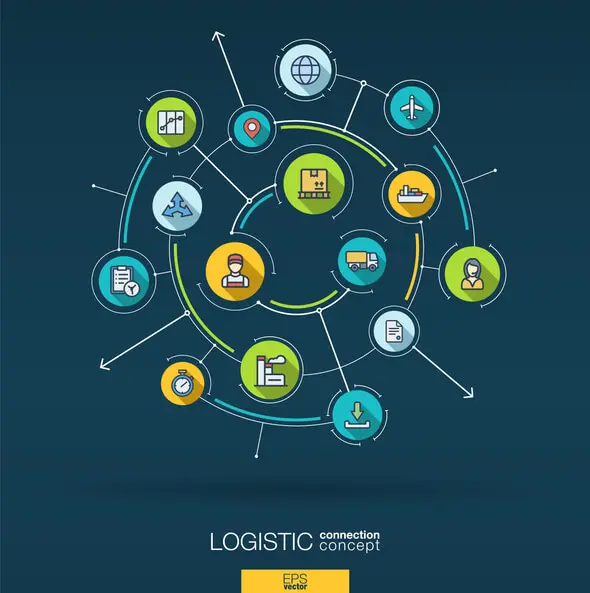Supply chain management is a complex and dynamic process that involves many factors and challenges with one of the most important aspects being, undoubtedly, the planning thereof. Effective planning is essential for any business in order to achieve its goals and objectives. This planning can be divided into two main categories: demand planning and supply planning. These are two separate, albeit interrelated processes, that aim to optimize the balance between customer demand and inventory production. In this article, we will explain what demand planning and supply planning are, why they are important, how they differ, and how they can be aligned for a successful supply chain.
Demand Planning Overview
Let us take a closer look at demand planning and what it entails. As its name implies, demand planning is the process of predicting and influencing customer demand for a product or service based on historical data, current trends, and future projections. Demand planning aims to estimate the quantity and timing of customer orders, as well as the factors that influence them, such as seasonality, promotions, price changes, and customer preferences. Demand planning functions as a key input for supply planning, as it determines how much inventory a business needs to produce and maintain to meet customer demand. It is essential that accurate and reliable demand forecasts, reflecting customer needs and expectations, are provided. This will in turn support decision-making and planning across various functions and levels of the organization, such as sales, marketing, finance, and operations. Demand planning ultimately allows for the alignment of demand with supply and business goals, such as service level, inventory level, and profitability.
In order to identify patterns and trends, data collection and analysis play an integral role in demand planning. This involves gathering and analyzing historical sales and related data, such as market share, customer segmentation, product mix, and demand drivers. Projections of future demand rely on the use of various statistical methods, such as time series analysis, regression analysis, and machine learning. Further refinement and validation of the demand forecast can be obtained through the collaborative planning process where data and inputs from various sources and stakeholders, such as sales, marketing, customers, and suppliers are integrated. By following a process of demand review and adjustment, deviations and errors may be identified and corrected, The demand forecast is compared with the actual demand and performance metrics, such as forecast accuracy, forecast error, and forecast bias. Demand communication and execution enable effective planning and execution. The demand forecast should be shared and communicated with all relevant parties and role-players, such as supply planners, production managers, and inventory managers.
Demand planning rests on a number of important key components. At its core is demand forecasting. This involves projecting future customer demand using various methods and tools. Demand sensing is yet another important component. This allows for the detection and response to changes in demand patterns and customer behavior and entails the capturing and analyzing of real-time data and signals, such as point-of-sale data, social media data, and sensor data. Customer demand can be positively influenced and stimulated by the use of various strategies and tactics, such as pricing, promotions, product launches, and product bundling, This is known as demand shaping.
Have a look at our free eBook on how to creat a black Friday promotions strategy with Intuendi AI:
Of course, demand planners are faced with a variety of challenges. Data quality and availability is one such challenge. Demand planning requires accurate and timely data from various sources, which can be difficult to obtain, integrate, and validate. Demand forecasting is also made more challenging and complex due to demand variability and uncertainty. Demand can fluctuate and change due to various factors, such as seasonality, competition, customer preferences, and external events. Demand planning requires collaboration and alignment among various stakeholders, such as sales, marketing, customers, and suppliers. Conflicting interests, goals, and incentives can be a hindrance. In addition, demand planning requires demand responsiveness and agility; the ability to quickly and effectively adapt to changes in demand and supply, and also to anticipate and mitigate risks and disruptions.
Despite the challenges that may be faced, the benefits of demand planning can not be denied. Effective demand planning can lead to increased customer satisfaction by meeting their expectations and delivering high-quality products and services. In so doing, customer loyalty is ensured. Furthermore, demand planning can drastically reduce costs and waste while optimizing resource utilization; overstocking or understocking can be avoided and inventory holding and transportation costs minimized. Through the demand planning process, sales opportunities can be maximized and market share captured which in turn leads to increased revenue and profitability, ultimately enhancing the competitive advantage. Demand planning also allows for the anticipation of changes in demand and supply, as well as external factors such as market trends, competitors, regulations, and disruptions. Risks and uncertainties are mitigated by timeous responses to these factors.
Supply Planning Overview
Supply planning is the process of determining how a business will fulfill the forecasted customer demand while still meeting its financial and service goals. Supply planning considers the manufacturing process constraints, such as capacity, lead time, minimum order quantity, and safety stock, to produce a supply plan that aligns with demand and business limitations. Supply planning is a key output of demand planning, as it determines how much inventory a business needs to produce and maintain to meet customer demand. Supply planning ensures the provision of optimal and feasible supply plans that balance demand and supply, as well as cost and service. It supports decision-making and planning across various functions and levels of the organization, such as operations, finance, and logistics. Supply planning also aligns supply with demand and business goals, such as service level, inventory level, and profitability.
The supply planning process involves master production scheduling where the quantity and timing of finished goods production are determined. This is based on the demand forecast, production capacity, and inventory policy. Material requirements planning, which is based on the master production schedule, the bill of materials, and the inventory policy, allows for the calculation of the quantity and timing of raw materials and components that are needed for production. The demand forecast, transportation capacity, and the inventory policy determine distribution requirements planning. This involves the allocation and distribution of the finished goods from the production facilities to the distribution centers and customers. Supply review and adjustment is an important component as it allows for the identification and correction of any deviations or errors. The supply plan is compared with actual supply and performance metrics, such as fill rate, inventory turnover, and inventory cost. Supply communication and execution are crucial. By communicating and sharing the supply plan with relevant parties, such as production, inventory, and logistics managers, they are able to plan and execute accordingly.
The core component of supply planning is master production scheduling. This involves planning the production of finished goods based on the demand forecast and the production capacity. This, in turn, leads to material requirements planning. The procurement of raw materials and components is based on the master production schedule and the bill of materials. The next step is distribution requirements planning which involves planning the distribution of finished goods from the production facilities to the distribution centers and customers. This is determined by the demand forecast and transportation capacity.
As in demand planning, supply planning also presents itself with a number of challenges. Capacity constraints and bottlenecks can occur as a result of limited production and transportation capacity brought about by factors such as equipment, labor, and resources. Supply planning requires balancing inventory levels and costs, which can be affected by factors such as demand variability, lead time variability, and service level requirements. Furthermore, collaboration and coordination among various parties, such as suppliers, manufacturers, distributors, and customers is very important but can be hindered by information asymmetry, communication barriers, and trust issues. Supply planning calls for supply responsiveness and resilience; the ability to quickly and effectively adapt to changes in demand and supply as well as to anticipate and mitigate risks and disruptions. As with demand planning, supply planning comes with the same multitude of benefits such as improved service level and customer satisfaction, reduced inventory cost and waste, increased operational efficiency and productivity, and mitigated risks and uncertainties.
Comparison Between Demand Planning and Supply Planning
Although interrelated, demand planning and supply planning have a number of differences. While demand planning is focused on forecasting and influencing customer demand, supply planning is focused on planning and managing the production and distribution of products. Demand planning is based on historical sales and related data, as well as inputs from various sources and stakeholders, while supply planning is based on the demand forecast, the production capacity, and the inventory policy. Statistical methods, such as time series analysis, regression analysis, and machine learning are used to project future demand in the process of demand planning as opposed to supply planning which makes use of mathematical models, such as master production scheduling, material requirements planning, and distribution requirements planning, to calculate the required supply. Where demand planning involves demand forecasting, demand sensing, and demand shaping, supply planning involves master production scheduling, material requirements planning, and distribution requirements planning.
Demand planning and supply planning require different levels of flexibility and adaptability, as they deal with different sources and degrees of uncertainty and variability. Demand planning requires more flexibility and adaptability, as it faces more uncertainty and variability from external factors, such as customer behavior, market trends, competitors, and disruptions. Supply planning requires less flexibility and adaptability, as it faces less uncertainty and variability from internal factors, such as production capacity, lead time, and inventory policy.
Demand planning and supply planning use different performance metrics to measure and evaluate their effectiveness and efficiency. Demand planning uses metrics such as forecast accuracy, forecast error, and forecast bias, which measure how close the demand forecast is to the actual demand. Supply planning uses metrics such as fill rate, inventory turnover, and inventory cost, which measure how well the supply plan meets the demand and the business goals. Where demand planning is more proactive, strategic, customer-oriented, and market-driven, supply planning is more reactive and operational, product-oriented, and resource-driven. As such demand planning is more uncertain and variable as opposed to supply planning which is deterministic and stable. Both demand planning and supply planning are aligned with the overall business goals of a supply chain, such as customer satisfaction, cost reduction, revenue growth, and risk mitigation. However, they may have different priorities and trade-offs depending on the specific business context and strategy.
A business that operates in a highly competitive and dynamic market may prioritize demand planning over supply planning, as it needs to constantly monitor and respond to customer demand and market trends, as well as to differentiate itself from competitors through demand-shaping strategies. However, a business that operates in a highly regulated and stable market may prioritize supply planning over demand planning, as it needs to ensure compliance and reliability of its production and distribution processes, as well as optimize its resource utilization and inventory management. Demand planning and supply planning need to be coordinated and synchronized, as any changes or discrepancies in either process can affect the other and cause issues such as stockouts, excess inventory, or missed sales opportunities.
Demand Planning vs Supply Planning: Final Thoughts
As has been pointed out, demand planning and supply planning are both important and essential for a successful supply chain. They do, however, have different characteristics, challenges, and benefits, which require different approaches, methods, and tools. Therefore, it is crucial for a business to understand the differences and similarities between demand planning and supply planning, as well as to align and coordinate them for a harmonious and efficient supply chain.






